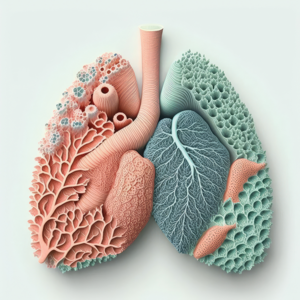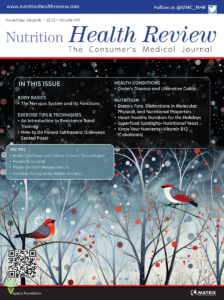 According to the World Health Organization (WHO), asthma is one of the most common chronic conditions in the world.1 The Global Initiative for Asthma (GINA)defines asthma as “a heterogeneous disease, usually characterized by chronic airway inflammation…[with] a history of respiratory symptoms, such as wheeze, shortness of breath, chest tightness, and cough, that vary over time and intensity, together with variable expiratory airflow limitation.”2 Asthma is more prevalent in developed countries than in low-to-middle income countries,3 which is thought to be related to the greater incidence of urbanization/westernized lifestyle, higher rates of obesity, and/or pollution in first-world regions.4
According to the World Health Organization (WHO), asthma is one of the most common chronic conditions in the world.1 The Global Initiative for Asthma (GINA)defines asthma as “a heterogeneous disease, usually characterized by chronic airway inflammation…[with] a history of respiratory symptoms, such as wheeze, shortness of breath, chest tightness, and cough, that vary over time and intensity, together with variable expiratory airflow limitation.”2 Asthma is more prevalent in developed countries than in low-to-middle income countries,3 which is thought to be related to the greater incidence of urbanization/westernized lifestyle, higher rates of obesity, and/or pollution in first-world regions.4
What Causes Asthma?
Asthma has several root causes involving endogenous (e.g., immune system functioning, age, sex) and/or exogenous (e.g., lifestyle, environmental exposures) factors.3 Most cases of asthma develop during childhood in association with immunoglobulin E (IgE) sensitization—which is when the body develops IgE antibodies, due to an abnormal lymphocyte T-helper type 2 (Th2) immune response, against common environmental allergens.3,5 However, asthma can develop later in life, and late-onset asthma may be more closely linked to environmental exposures. Clusters of observable characteristics (e.g., demographics, symptomatology, pathophysiology) have been identified and categorized into asthma “phenotypes,” which include allergic asthma, nonallergic asthma, adult onset (late onset) asthma, asthma with persistent airflow limitations, and asthma with obesity.2
What happens during an asthma attack?
When a pollutant or other environmental trigger (e.g., house dust mites, animal allergens, mold) is inhaled, sensitized IgE antibodies are released by plasma cells. IgE antibodies then attach to high-affinity mast cells and basophils, which release cytokines that in turn trigger the release of histamine, prostaglandins, and leukotrienes. These cells then signal the smooth muscle surrounding the bronchi and bronchioles in the lungs to contract, causing the airway to constrict. During this process and over the next several hours, Th2 cells produce and send several immune-response cells to the lungs, which causes and sustains inflammation in which the inner lining of the airways swells and produces mucus.6 This combination of constriction, inflammation, and mucous make it difficult for a person to breathe normally.
What Are the Risk Factors for Asthma?
According to the American Lung Association, risk factors for asthma include the following:7
• Family history—Having a parent with asthma increases a child’s risk of developing the disease 3- to 6-fold.
• Allergies—Certain allergic conditions, such as eczema and hay fever, are associated with the development of asthma.
• Viral respiratory infections—Children who experience viral respiratory infections are at greater risk of developing chronic asthma.
• Occupational exposures—Exposure to certain industrial or wood dusts, chemical fumes and vapors, and molds can increase the risk of developing late-onset asthma (i.e., developing asthma as an adult with no previous history of the disease).
• Smoking—Smoking not only increases risk of developing asthma, but causes more severe symptoms and makes the disease more difficult to treat. Those whose mothers smoked during pregnancy or who have been exposed to secondhand smoke are also more likely to develop asthma.
• Air pollution exposure—Exposure to ground-level ozone, the main component of smog, increases the risk for asthma.
• Obesity—Being overweight or obese increases the risk of developing asthma, though the reasons for this are unclear. Low-grade inflammation in the body that occurs with extra weight is thought to be a factor. People with asthma who are obese typically have worse symptoms and more difficulty controlling their disease, compared to those with normal weight.7
How is Asthma Treated?
While there is no cure for asthma, there are several treatment options and techniques to help manage or prevent exacerbations.
Medications. Inhaled corticosteroids (ICSs)—ICSs are considered a first-line treatment option for asthma and are used as a maintenance therapy.2,8 ICSs work by regulating capillary permeability and lyosomal activity at the cellular level to reduce inflammation. ICSs can be delivered to the lungs by way of nebulizer (a device that turns the liquid medicine into a mist, which is then inhaled through a mouthpiece or mask), metered dose inhaler (a device that delivers a measured amount of medication as a mist, which is inhaled through a mouthpiece), or dry powder inhaler (a portable device that is breath-activated, delivering the medication when the individual takes a deep, fast breath through the inhaler). With consistent use, it can take hours to days for an ICS to reach its full therapeutic benefit.8
Short-acting beta-2 agonists (SABAs)—SABAs, also considered a first-line treatment option in asthma, are typically used as “rescue” medication because they provide quick relief (in under 5 minutes) from exacerbated asthma symptoms, as well as prevent exercise-induced asthma attacks. SABAs work by modulating the bronchial smooth muscle, causing the airway to dilate and relax, which makes breathing easier. SABAs can be administered in the form of an inhaler, nebulizer solution, or tablet, and can be used as a monotherapy or in combination with other agents.2,9
Long-acting beta-2 agonists (LABA)—LABA inhalers, such as formoterol, dilate and relax the airway via modulation of the bronchial smooth muscle. Though quick to work compared to an ICS, formoterol usually takes at least five minutes provide relief and so does not work as quickly as a SABA. But formoterol has long-term therapeutic effects, and thus can be used for symptom relief and/or, when combined with an ICS, as a long-term maintenance therapy. Formoteral is available as a monotherapy or in combination with an ICS and/or SABA.2,10
Long-acting muscarinic agonists (LAMAs)—LAMAs have long been used in the treatment of chronic obstructive pulmonary disease (COPD). Recently, however, tiotropium became the first (and only, so far) LAMA inhaler to be FDA-approved for the treatment of asthma. Tiotropium works by inhibiting muscarinic-3 (M3) receptors, which results in reduced inflammation and increased bronchodilation. Tiotropium is recommended for use in adolescents and adults with poorly controlled asthma who are not adequately responding to first-line treatments.
Treatment recommendations. Current guidelines. Current guidelines recommend using a step up/step down approach when treating asthma. In adults and adolescents with mild asthma, the preferred initial treatment is a low-dose ICS-formoteral combination therapy taken as needed for symptom relief. For moderate asthma, a low-dose ICS-formoteral combination therapy taken on a daily basis is recommended. For more severe asthma, medium-dose ICS-formoteral combination therapy is recommended. For severe asthma that fails to respond adequately to previous treatments, the dosage of ICS-formoteral therapy may be increased and tiotropium therapy may be initiated.
Though not the GINA Science Committee’s preferred initial treatment method, for individuals with asthma for whom the preferred method is not possible or for those with stable asthma (i.e., haven’t had an exacerbating event within the last year) who are adherent to their current treatment regimen, SABA monotherapy or ICS-SABA combination therapy on an as needed or daily basis may be recommended.2
Lifestyle modifications. GINA guidelines2 recommend the following lifestyle modifications to mitigate symptoms/exacerbations of asthma:
1. Quit smoking and/or avoid second-hand smoke exposure.
2. Get regular exercise. Exercise can improve cardiopulmonary functioning and improve quality of life. Individuals with exercise-induced asthma should consult with their physician on ways to prevent breakthrough symptoms while exercising.
3. Avoid occupational exposure to irritants (e.g., industrial dusts, gases).
4. Consume a diet high in fruits and vegetables. Several studies have found a positive association between regular consumption of fruits and vegetables and improvement in asthma symptoms.11 A reduction in proinflammatory cytokines and increase in anti-inflammatory markers have been linked to increased fruit and vegetable intake in children and adults with asthma.11
(see sidebar “Nutrition and Lung Health”)
5. Lose weight. For individuals with overweight or obesity, a physician-monitored weight loss program that includes both diet modification and regular strength and aerobic exercise is more effective in improving asthma symptoms than diet modification alone.
6. Avoid outdoor allergens and air pollution. If sensitive to outdoor allergens, such as pollen and mold, and/or air pollution, keeping inside a climate-controlled environment as much as possible, with windows and doors shut, when environmental conditions are unfavorable may help mitigate exposure.
7. Address emotional stress. In some individuals, emotional stress can worsen the symptoms of asthma. Seeking help from a qualified mental health professional is recommended in individuals with asthma who are experiencing symptoms of anxiety or depression.
Bottom Line
Asthma is a chronic condition of the respiratory system that involves abnormal immune-system functioning and environmental exposures. Genetics are thought to play a role in its development; however, exposure to occupational or environmental contaminants, having overweight or obesity, and/or lifestyle factors such as smoking have all been linked to developing asthma in adulthood. There is no cure for asthma, but there are medications that can help control and prevent exacerbations of the disease, including inhaled corticosteroids, short- and long-acting beta-2 agonists, and long-acting muscarinic agonists. Environmental and lifestyle modifications, such as avoiding triggering occupational/environmental contaminants, eating plenty of fresh fruits and vegetables, getting regular exercise, stopping smoking, and losing weight, can also help improve symptoms.
Editor’s note: Consult with your physician if you think you have asthma or if your existing asthma is not improving with treatment.
Sources
1. World Health Organization (WHO). Chronic respiratory diseases: asthma. 3 May 2021. https://www.who.int/news-room/questions-and-answers/item/chronic-respiratory-diseases-asthma. Accessed 3 May 2023.
2. Global Initiative for Asthma. Global Strategy for Asthma Management and Prevention—2023. Updated May 2023. https://ginasthma.org/2023-gina-main-report/. Accessed 3 May 2023.
3. Holgate ST, Wenzel S, Postma DS, et al. Asthma. Nat Rev Dis Primers. 2015 Sep 10;1(1):15025.
4. Enilari O, Sinha S. The global impact of asthma in adult populations. Ann Glob Health. 2019;85(1):2.
5. Skaaby T, Husemoen LL, Thuesen BH, et al. IgE sensitization to inhalant allergens and the risk of airway infection and disease: a population-based study. PLoS One. 2017;12(2):e0171525.
6. Sinyor B, Perez LC. Pathophysiology of asthma. StatPearls [internet]. 8 May 2022. Treasure Island (FL): StatPearls Publishing; 2023 Jan-. https://www.ncbi.nlm.nih.gov/books/NBK551579/. Accessed 3 May 2023.
7. American Lung Association. Asthma causes & risk factors. 19 Apr 2023. https://www.lung.org/lung-health-diseases/lung-disease-lookup/asthma/learn-about-asthma/what-causes-asthma. 3 May 2023.
8. Liang TZ, Chao JH. Inhaled corticosteroids. [Updated 2022 May 15]. In: StatPearls [Internet]. Treasure Island (FL): StatPearls Publishing; 2023 Jan-. Available from: https://www.ncbi.nlm.nih.gov/books/NBK470556/
9. Hsu E, Bajaj T. Beta 2 agonists. [Updated 2022 Jun 23]. In: StatPearls [Internet]. Treasure Island (FL): StatPearls Publishing; 2023 Jan-. Available from: https://www.ncbi.nlm.nih.gov/books/NBK542249/
10. Drug Bank Online website. Formoteral. https://go.drugbank.com/drugs/DB00983. Accessed 8 May 2023.
11. Alwarith J, Kahleova H, Crosby L, et al. The role of nutrition in asthma prevention and treatment. Nutr Rev. 2020;78(11):928-938.





